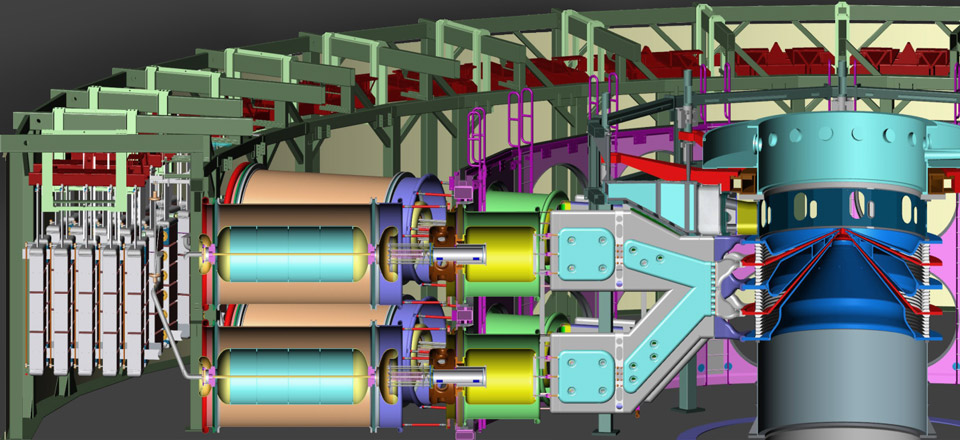Marx Bank Generator
Marx Bank. Each Marx bank has sixty 2.6 μF capacitors (43 nF per Marx when erected) that are charged in parallel and discharged in series. When charged to 85 kV its output voltage is 5.1 MV, and stored energy is 20 MJ for all 36. (For a 90 kV charge it is 5.4 MV and 23 MJ.) When discharged, the peak current of each Marx is about 150 kA with a 1.5 μs time to peak.
Intermediate-Store Capacitor
Intermediate-Store Water Capacitor. The output of each Marx is dumped into a 6.5-ft diameter, 10-ft long (24 nF, 3.8 Ω) coaxial cylinder filled with water. This cylinder sits in the oil tank and has polyurethane barriers on each end. It acts as a large capacitor that accumulates the energy from the Marx. When it reaches full voltage (5.1 to 5.4 MV) it is discharged downstream by a laser-triggered switch with a peak current of 600 kA with a rise time of 500 ns.
Laser-Triggered Gas Switch
Laser-Triggered Switch. Each module has a multi-electrode rim-fire laser-triggered switch that is 18″ in diameter and 32″ long. Each switch holds off up to 5.4 MV and is triggered by a 15 mJ Nd:glass laser. Since each switch has its own laser, it’s possible to tailor the output pulse of Z by staggering the laser fire time for each switch, thus adding currents from individual modules at different times.
Pulse-Forming Line
Pulse-forming line. The intermediate store energy is dumped into a 66″ (1.7 m) diameter, 54″ (1.4 m) long coaxial water cylinder that acts as a second water capacitor (15 nF, 2.7 Ω). Its output is 700 kA with a 200 ns rise-time. It is discharged through self-breaking water switches.
Self-Break Water Switches
Self-Break Water Switches. Each pulse-forming line output has a set of three self-breaking water switches, the output voltage of which is adjusted by varying the gap between the upstream and downstream electrodes. Since these explode water in a channel between the electrodes these switches are a source of much of the mechanical shock of the machine as it fires.
Vertical to Horizontal Convolute
Vertical to Horizontal Convolute. Just outside the vacuum insulator each vertical tri-plate is joined to four horizontal disk transmission lines through a vertical to horizontal constant impedance structure.
Magnetically Insulated Transmission Lines
Magnetically Insulated Transmission Lines. Connected to the vacuum side of the electrode rings of the interface are five nesting stainless-steel cones (total weight about 10 tons (9 metric tons)) that are vacuum transmission lines, and are only separated by 1 cm near the center of the machine. As machine current rises these become magnetically insulated, preventing shorting across these lines. They are refurbished after each shot.
Sandia’s Z machine uses electricity to create radiation and high magnetic pressure, which are both applied to a variety of scientific purposes ranging from weapons research to the pursuit of fusion energy.
The process starts with wall-current electricity, which Z uses to charge large capacitors — structures designed to store an electric charge and release it instantaneously. In every shot the machine consumes only about as much energy as it would take to light 100 homes for a few minutes. Metal cables arranged like the spokes of a wheel connect the capacitors to a central vacuum chamber, 10 feet in diameter and 20-feet high. The cables, some insulated by water and some by oil, are each as big around as a Volkswagen Beetle and 30-feet long.
When the accelerator fires, powerful electrical pulses strike a target at the center of the machine. Each shot from Z carries more than 1,000 times the electricity of a lightning bolt, and is 20,000 times faster. The target is about the size of a spool of thread, and it consists of hundreds of tungsten wires, each thinner than a human hair, enclosed in a small metal container known as a hohlraum (German for hollow space). The hohlraum serves to maintain a uniform temperature.
The flow of energy through the tungsten wires dissolves them into plasma and creates a strong magnetic field that forces the exploded particles inward. The speed at which the particles move is equivalent to traveling from Los Angeles to New York – about 3,000 miles – in slightly less than one second. The particles then collide with one another along the z axis (hence the name Z machine), and the collisions produce intense radiation (2 million joules of X-ray energy) that heats the walls of the hohlraum to approximately 1.8 million degrees Celsius.
Instruments that measure these implosions must be even faster in order to record the details of the process. This is an added challenge for researchers who rely on the accuracy of these measurements to understand Z’s results and nuclear events in general. Accurate measurements allow scientists to experiment with a variety of target arrangements to create conditions useful for many different purposes.
